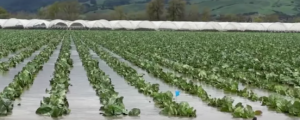After the driest three years on record, California dairy producers are reeling from storms that have displaced families and cattle, damaged farms and feed supplies, and severely impacted crops grown to feed the state’s 1.7 million dairy cows. California dairy farmers are now bracing for more flooding as temperatures rise and this year’s historic Sierra snowpack thaws.
Federal, state, and local officials are working to repair damaged canals, levees, and roads while preparing flood barriers and limiting reservoir water levels to leave room for melting snow. However, overflowing water continues to impact the nation’s top-producing dairy region, and farmers’ full losses have yet to be realized.
Record snowmelt has fed Tulare Lake Bed, a “ghost” lakebed impacting surrounding agricultural operations. Tulare County’s top agricultural commodity is dairy, and more than a dozen dairies are located near the old Tulare Lake Bed. According to the Tulare County Farm Bureau, the state just isn’t well-equipped to handle extreme weather and wet-weather events.
Kings County officials told the Fresno Bee that flooding will ruin 41 percent of the county’s $2.43 billion crop value and cause an additional $1 billion in damages.
Brian Ferguson, spokesman for the Governor’s Office of Emergency Services, told CalMatters, “We’re paying particular attention to the Tulare basin because there’s already so much water in the system, and that’s where the snowpack is really concentrated,” he said. “Humans, in many cases, are the hardest part of any disaster to control.”
The National Milk Producers Federation is working with affected members, federal agencies, and Congress to mobilize meaningful, timely support for California dairy farmers and secure future funding and support for critical water infrastructure and storage.
Preparation and response
The resources below outline how dairies can best prepare for and respond to flooding emergencies. For immediate help, producers should contact local emergency management officials or dial 2-1-1. California dairy farmers are urged to keep in close contact with their county agriculture commissioners when dealing with losses and problems on the farm, as they are the best local resource for agriculture-related information and are tasked with collecting data for USDA disaster assistance.
- California Dairies: Coping with Flooding and Evacuation, California Dairy Quality Assurance Program
- Action-Items for Emergency Flood Evacuation for a Dairy, California Dairy Quality Assurance Program
- Managing Dairies During Heavy Rainfall: Actions Producers Can Take In-Between Rain Storms, California Dairy Quality Assurance Program
- Flooding and Livestock Owners: Preparing, Responding and Recovering, UC Davis
- Developing a Storm Preparedness and Response Plan for Dairies, University of Georgia Extension
- Forage and Livestock Management after a Flood, West Virginia Extension
- Managing Flood-Damaged Crops, Penn State Extension
- Disaster Resource Center, USDA

Recovery programs
USDA is offering technical and financial assistance to help California dairy farmers recover. Affected producers should contact their local USDA Service Center to report losses and learn more about program options available to assist in their recovery from crop, land, infrastructure, and livestock losses and damages. Applicable programs include:
- Emergency Conservation Program: The Emergency Conservation Program (ECP) helps farmers repair damage to farmlands caused by natural disasters and put in place methods for water conservation during severe drought. The ECP does this through funding and technical assistance. (Application deadline: Oct. 13)
- Emergency Farm Loans: Farm Service Agency emergency loans help producers who suffer qualifying farm-related losses directly caused by the disaster in a county declared or designated as a primary disaster or quarantine area. Also, farmers located in counties contiguous to the declared or designated area may qualify for loans. (Application deadline: Within eight months of disaster declaration)
- Livestock Indemnity Program: The Livestock Indemnity Program (LIP) benefits livestock producers for livestock deaths over normal mortality caused by adverse weather or by attacks by animals reintroduced into the wild by the Federal Government. LIP payments are equal to 75 percent of the average fair market value of the livestock. (Application deadline: File of Loss must be filed within 30 days of the event or when loss becomes apparent)
- Emergency Assistance for Livestock, Honeybees, and Farm-Raised Fish Program: The Emergency Assistance for Livestock, Honeybees, and Farm-Raised Fish Program (ELAP) provides financial assistance to eligible livestock producers for losses due to certain adverse weather events or loss conditions. Assistance can cover the loss of grazing land and stored feed losses. (Application deadline: File of Loss must be filed within 30 days of the event or when loss becomes apparent)
- Environmental Quality Incentives Program: While not designed to be an emergency response program, the Environmental Quality Incentives Program (EQIP) can assist producers in recovering from natural disasters. Through EQIP, USDA’s National Resources Conservation Service provides financial assistance to repair and prevent excessive soil erosion caused or impacted by natural disasters.
Click here to navigate the U.S. Department of Agriculture’s Disaster Assistance Discovery Tool. The discovery tool walks producers through five questions to help them identify personalized results of what USDA disaster assistance programs may meet their needs.
Additional federal relief is available in counties declared major disaster areas. Assistance can include grants for temporary housing and home repairs, low-cost loans to cover uninsured property losses, and other programs to help individuals and business owners recover from the effects of the disaster.


